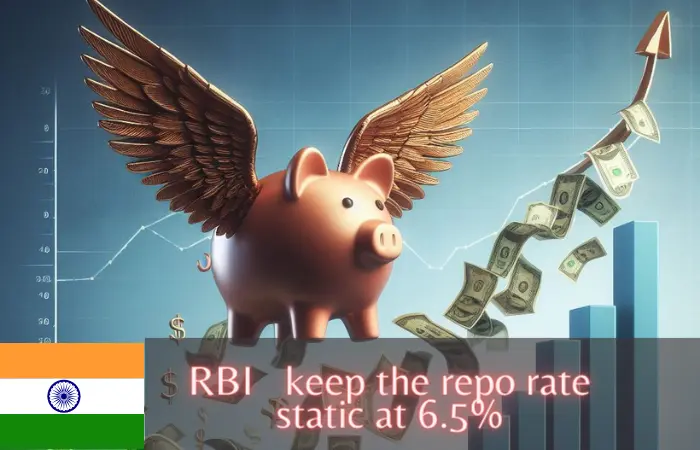A storm of dissenting opinions broke out among economists and industry tycoons over the decision of Reserve Bank of India (RBI) to keep the repo rate static at 6.5%, in what is the latest twist in India’s current economic saga. As a result, this has put the country at crossroads where every step seems to offer both hope and danger.
For Status Quo:
Those for maintaining the repo rate say that it would be prudent amidst growing inflationary pressures in the economy. With an inflation rate obstinately above RBI’s target range of 4%, keeping repo rates unchanged acts as a countermeasure against rising prices which are slowly but surely catching up with us. In other words, this conservative approach signifies wielding a fiscal responsibility wand for those who governs, meaning that central banks are determined to domesticate inflation monster at its infancy before it can cause more havoc on ordinary citizens’ lives.
The RBI’s decision to keep the repo rate unchanged resonates with its aim to stabilize the depreciating rupee against the US dollar. It opted to retain the repo rate. Despite global economic instability, keeping interest rates unchanged calms domestic currency markets. However not everyone agrees as they suggest that lowering the repo rate can be India’s savior from its economic downturn. This means that by reducing bank lending rates for firms, they will promote investments and consequently promote more growth in business on a broad perspective. In this regard, it is believed that the repo rate acts as an effective catalyst in bringing back life into India’s stalling economy. It therefore marks a new beginning of prosperity and optimism.
India’s Projected GDP Growth by RBI and IMF
India’s economic path for fiscal year2024-2025 with different forecasts coming from the Reserve Bank of India (RBI) and International Monetary Fund (IMF). RBI has a positive outlook showing that India GDP is expected to grow at 7%. It holds this view due to anticipated revival of local demand, an extensive government expenditure on infrastructure as well as an upside in export performance. On the other hand, IMF has slashed its projection for India from 7% to 6.5%, reflecting confidence amidst global economic challenges. IMF while acknowledging the resilience of India, has qualms about persisting uncertainties and underlying structural issues facing the Indian economy; these differing viewpoints illustrate the intricacy of Indian economics thus emphasizing the need for flexible policy formulation when moving forward.
Also Read- India’s Ascension: Jefferies Predicts Third-Largest Economy Status by 2027
Inflation in India
With the recent data from the Ministry of Statistics and Programme Implementation (MOSPI) showing a rise in retail inflation to 5.5% in March 2024, up from 5.2% in February 2024, the Indian government and central bank are both now faced with very serious concerns about inflation. The Reserve Bank of India (RBI) is determined to control inflation with a view to reducing it to its target of 4% by the end of two quarters. However, this task is even more challenging due to several factors that have made it more difficult. For instance, an increase in global commodity prices resulting from geopolitical tensions and supply bottlenecks has put pressure on domestic inflationary conditions, In addition, the weak rupee makes things worse since it leads to higher import costs that ultimately contribute a lot towards rising domestic inflation rate, Hence the RBI is using various monetary policy tools for combating price hikes by finding a delicate equilibrium between supporting economic expansion as well as controlling price increases. Nevertheless, attaining this desired inflation target is an uphill battle compounded by numerous factors which requires concerted efforts by stakeholders and policy makers alike.
Also Read – India’s Stock Market Outlook: A 9% Rise Anticipated in 2024, According to Recent Poll
Some Frequently Asked Questions:
Why did the RBI maintain the repo rate?
The RBI might be taking a cautious approach to balance two key concerns: inflation and economic growth. While inflation is still above their target, keeping the rate high helps control it. However, a lower rate could boost economic activity.
How will the current repo rate impact my loan interest rates?
The repo rate influences the interest rates that commercial banks offer on loans. A higher repo rate generally translates to higher loan interest rates. However, the exact impact might vary depending on the bank and the type of loan.
Is 7% GDP growth realistic for India?
The RBI’s projection of 7% growth is optimistic, but achievable. Factors like reviving domestic demand, increased government spending, and a potential pick-up in exports could support this growth. However, global uncertainties and domestic challenges could pose risks.
What are the risks to India’s economic growth?
A global slowdown, geopolitical tensions, and domestic policy uncertainties are some potential risks. These factors could dampen investment, disrupt supply chains, and impact consumer spending, hindering growth.
Why is inflation rising in India?
Several factors are contributing to rising inflation, like rising global commodity prices due to geopolitical tensions. Supply chain disruptions and a depreciating rupee are also putting upward pressure on prices.
What is the RBI doing to control inflation?
The RBI is using various tools, including monetary policy. By maintaining the repo rate, they aim to control inflation without hindering growth too much. Other tools like open market operations can also be used to manage inflation.
How will high inflation impact my household budget?
High inflation can lead to rising prices of essential goods and services, impacting your purchasing power and potentially squeezing your household budget.
What can I do to protect myself from inflation?
There are a few strategies you can consider > Invest in assets that tend to perform well in inflationary times, such as real estate or certain stocks. > Review your budget and identify areas where you can cut back on spending. > Look for ways to increase your income, potentially through upskilling or exploring side hustles.
Why do some economists advocate for lowering the repo rate?
Advocates for a repo rate cut believe it could be instrumental in revitalizing India’s slowing economy. By reducing borrowing costs for businesses, it can encourage investment and foster growth, ultimately leading to economic revival.
What are the projections for India’s GDP growth by RBI and IMF for the fiscal year 2024-2025?
The RBI projects a GDP growth rate of 7% for FY 2024-2025, citing factors such as a revival in domestic demand, increased government infrastructure spending, and improved export performance. On the other hand, the IMF has revised its projection to 6.5%, reflecting confidence amidst global economic challenges but also acknowledging persisting uncertainties and structural issues within the Indian economy.







